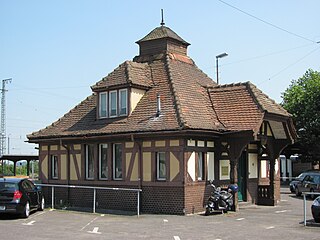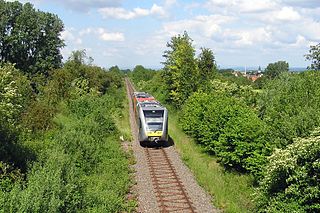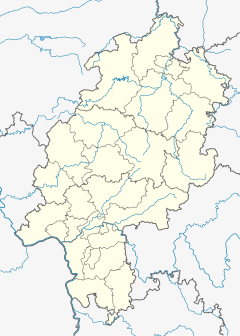The Taunus Railway in the High Taunus is a railway route between Frankfurt (Main) Hauptbahnhof and Brandoberndorf via Bad Homburg, Usingen and Grävenwiesbach. It was operated from 1993 to 1995 by the Frankfurter Verkehrsverbund as the T-Bahn and subsequently by the Rhein-Main-Verkehrsverbund as line 15. It is listed in table 637 of the Deutsche Bahn timetable. The Friedrichsdorf–Brandoberndorf line, which has the infrastructure number of 9374, forms part of the old Friedrichsdorf–Wetzlar line, which was known as the Taunusbahn. The line is owned by the Verkehrsverband Hochtaunus. The infrastructure is managed by HLB Basis AG on behalf of the VHT.

The Taunus Railway is a double-track electrified railway line, which connects Frankfurt and Wiesbaden, Germany. It is 41.2 km long and follows the course of the Main on its north side, running quite close to it in some places. Its first stage was opened in September 1839 and is thus the oldest railway line in the German state of Hesse and one of the oldest in Germany. Today it is used by Regional-Express trains between Frankfurt and Wiesbaden and the trains of line S1 of the Rhine-Main S-Bahn between Frankfurt-Höchst and Wiesbaden. Between Frankfurt Hbf and Frankfurt-Höchst, they run on the line of the former Hessian Ludwig Railway.

The Main–Weser Railway is a railway line in central Germany that runs from Frankfurt am Main via Gießen to Kassel. it is named after the railway company that built the line and also operated it until 1880. It was opened between 1849 and 1852 and was one of the first railways in Germany.

The Homburg Railway is an 18 km line from Frankfurt am Main to Bad Homburg in the German state of Hesse. It was opened in 1860 as one of the first railway lines in Germany. It is now part of the Rhine-Main S-Bahn line S5 to Friedrichsdorf.

The Frankfurt-Höchst station is an important station in the Frankfurt district of Höchst and is the second largest station in the city with twelve tracks. It is currently mainly used by S-Bahn, suburban and regional services.

Frankfurt (Main) West station is a railway station for regional and S-Bahn services in Frankfurt, Germany, on the Main-Weser Railway, in the district of Bockenheim, near the Frankfurt Trade Fair grounds and the Bockenheim campus of the Goethe University Frankfurt.

Frankfurt-Rödelheim station is a regional and S-Bahn station in western Frankfurt am Main, Germany on the Homburg line, in the district of Rödelheim. The Kronberg line branches off the Homburg line north of the station. The junction with the Rebstock curve of the former Bad Nauheim–Wiesbaden line (Bäderbahn) is south of the station. The station connects with several bus lines.

Oberursel (Taunus) station is a station on S-Bahn line S5 in Oberursel (Taunus), near Frankfurt am Main, Germany on the Homburg line. The former Mountain Railway ran from the station to Hohemark; it is now part of U-Bahn line U3.

Friedberg (Hess) station is the station of Friedberg, Germany, on the Main-Weser Railway.

Bad Soden (Taunus) station is the northern terminus of the Soden Railway in the German state of Hesse. It is also the northern terminus of line S3 of the Rhine-Main S-Bahn over the Limes Railway (Limesbahn).

Bensheim station is in the town of Bensheim on the Main-Neckar Railway, connecting Frankfurt and Heidelberg, in the German state of Hesse. The station is also the beginning and end of the single-track non-electrified Worms–Bensheim line. 114 trains stop at Bensheim station every day, of which about one-third are long-distance services. It is classified by Deutsche Bahn as a category 3 station. Bensheim station is protected as a cultural monument under the Hessian heritage legislation.

Hochheim station is situated on the Frankfurt–Wiesbaden line. It is in the town of Hochheim am Main, southwest of Frankfurt in the German state of Hesse. It is on the Taunus Railway from Wiesbaden to Frankfurt. The station is classified by Deutsche Bahn as a category 5 station.

Friedrichsdorf (Taunus) station is in the centre of Friedrichsdorf on Bahnstraße. Although the city has mostly dispensed with the appendage of "Taunus" in its name the station still officially retains it, although signs on the newest platform and Rhein-Main-Verkehrsverbund maps do not include it. The station is classified by Deutsche Bahn as a category 4 station.

Bad Nauheim station is a station in the town of Bad Nauheim in the German state of Hesse on the Main–Weser Railway. The station is classified by Deutsche Bahn (DB) as a category 4 station.

Langen (Hess) station is in the town of Langen in the German state of Hesse. It was opened in 1846 with the Main-Neckar Railway and is now served by the Rhine-Main S-Bahn. The station has two side platforms, an island platform and a through track without a platform. The station building and platform canopies are protected as monuments. It is classified by Deutsche Bahn as a category 4 station.

Bad Vilbel station is located at the 183.6 kilometre mark of the Main-Weser Railway in the town of Bad Vilbel in the German state of Hesse. The Nidder Valley Railway branches from Bad Vilbel via Nidderau to Glauburg-Stockheim. It is classified by Deutsche Bahn as a category 3 station.

The Friedrichsdorf–Friedberg railway is a single-track, non-electrified branch line in the German state of Hesse. It is listed as timetable route 636 and integrated in the Rhein-Main-Verkehrsverbund as line 16.

Usingen station is the station of Usingen in the German state of Hesse) and the operations centre of the Taunus Railway from Brandoberndorf via Grävenwiesbach and Usingen to Bad Homburg. The entrance building is heritage-listed.

Grävenwiesbach station is the station of Grävenwiesbach on the edge of the Hochtaunuskreis in the German state of Hesse. It is located on the southern outskirts of the town centre. Previously, the station was a junction station that served trains running on the Weil Valley Railway to Weilburg via Weilmünster, on the Taunus Railway to Bad Homburg and on the Solms Valley Railway to Wetzlar.

Flörsheim (Main) station is the station of Flörsheim am Main in the German state of Hesse. It lies on the Taunus Railway, which connects Frankfurt and Wiesbaden.
























